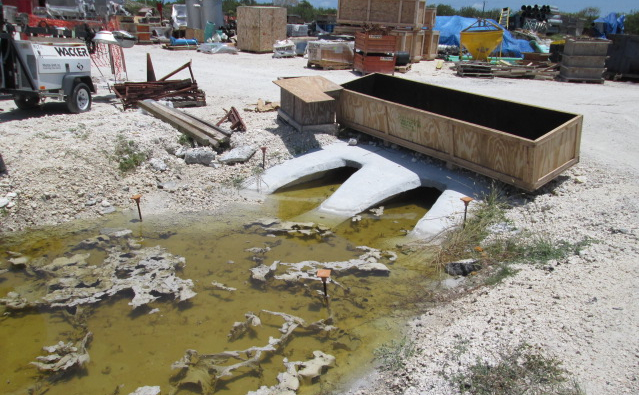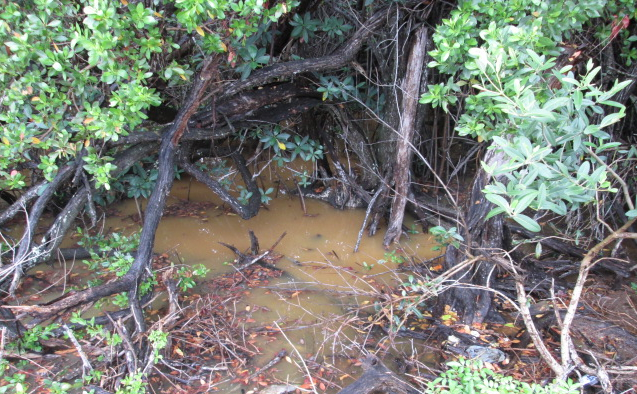GUEST EDITORIAL: The Real Story Behind the Resistance to Deep Well Wastewater Disposal
As a member of Dump the Pumps and worrying that the Cudjoe Regional Wastewater System [CRWS] is deeply flawed, I have been privy to documents and people associated with the group and some people you might want to call “whistleblowers” who are FKAA employees or contractors. Here’s some of what I have gleaned from these sources:
~~Harry Powel
~~~~~~~~~~~~~~~~~~~~~~~~~
The Cudjoe Regional Wastewater treatment plant currently under construction at the Cudjoe landfill has been challenged for its intended use of shallow injection wells for effluent disposal. There are a couple of property owner associations that fund the Dig Deep Cudjoe group that was formed to fight for deep well disposal of the partially treated wastewater. Rumor suggests that they may believe that FKAA is looking for a way to say to the County, “The science says we need a deep well.” Hence their optimism arising from FKAA’s offer to do a baseline study and 5 year monitoring near the Cudjoe treatment plant. That way FKAA can save face and begin deep well design and construction as if they are being environmentally responsible. Ha!
The motives and agenda of FKAA may be very different than what the POAs imagine. There may be still more trickery and deceit involved, as many have come to expect from FKAA. Consider the following…
The baseline monitoring and study was always a requirement of FDEP, who was initially reluctant to allow shallow wells even for temporary use. FDEP-FKAA meeting minutes say,
“FDEP stated that based on memorandum the maximum flow leaving the plant will be 2.35 mgd and therefore will require deep well injection in accordance with Chapter 99-395.”
After agreeing to allow an initial startup exception to use shallow wells, it was agreed that,
“The permit for the shallow wells will include special provisions for operational monitoring to confirm that no adverse environmental impacts are occurring.”
Legally, a treatment plant that is designed to treat over 1 mgd (million gallons per day) needs two deep wells in case one needs repair. FDEP allowed an exception to Florida law in Key Largo, and FDEP intended to allow the same exception in Cudjoe: shallow well backup for one deep injection well. FDEP and FKAA have always known the plant would receive over 1mgd when the Outer Islands connected. FDEP-FKAA meeting minutes say FKAA,
“may apply for 2 phase permit. Phase 1 for under 1 MGD, and Phase 2 to about 1.5 MGD.”
Yes, the DEP made an additional exception to Florida law by allowing the Cudjoe treatment plant to be permitted with shallow well disposal. The documentation is in hand to verify the above statements.
A More Believable Agenda?
Try this scenario for a more believable agenda behind FKAA’s proposal to the Dig Deep Cudjoe consortium: FKAA is trying to make the petitioners go away for five years so that they can start up the plant on shallow wells. Then they will “discover” that flow is “higher than anticipated” and build another smaller plant on or near BPK, which will be under 1 mgd. With the nearly half million gallons per day of sewage from Big Pine diverted away from Cudjoe, FKAA can then legally be below the 1 mgd trigger point for deep wells on both plants and will not be in such a serious bind when the Niles Channel crossing fails (and they know it probably will fail). FKAA can build another complete plant with shallow well injection for not too much more than the cost of a single deep well, and certainly for less than the cost of two deep wells plus another pipe under Niles Channel.
The old landfill at Cudjoe (“Trash Mountain”) is almost 50 feet high in layers of household, military, and commercial waste (much of it incinerated, creating verified hazardous heavy metal ash) along with septic tank pump-outs and treatment plant sewage sludge. There is no waterproof barrier underneath, but they laid a heavy duty plastic tarp (membrane) over it to reduce rainwater leaching through it. The mountain has collapsed a few feet in crater-like fashion on top, so it is not unlikely that the roughly 20 year old membrane tarp has torn, allowing rainwater to filter through the ash and septage, collecting pollutants into the local ground water and thence to Cudjoe Basin. This would explain why vegetative cover on Trash Mountain that was intended to curtail erosion is nearly gone- minimal water is being retained in the soil covering. “Long term maintenance” requirements by FDEP for the closed landfill were only for 20 years and expire soon, as if the hazards no longer exist! Use the archived satellite photography on Google earth to verify the shockingly rapid decline of vegetative cover in recent years.
Breaches in the landfill cover explain why excavations during treatment plant construction filled with yellow odoriferous water, and why runoff from the mountain’s drainage culverts is usually orange and often complete with foam and oil slicks. It has been seen running across the perimeter road into the wildlife refuge. Leachate explains why the monitoring wells show an elevated nitrogen content. Leachate explains why the waters of Cudjoe basin near the landfill are outrageously high in nitrogen and choked with algae, overwhelming the native seagrass.
Now what happens when the water flow out of the landfill/treatment plant site increases by hundreds of thousands of gallons per day? FKAA-FDEP meeting minutes say,
“Existing site will need evaluation for: Potential migration of landfill leachate resulting from construction and/or operation of new WRF”.
Dirty Industry proclaims, “The solution to pollution is dilution!” One can see where pollutant levels might rise initially while the heavily contaminated soil is washed with less contaminated wastewater plant effluent. Then, as the contaminated soil is rinsed and rinsed, the strong evil brew from the mountain of pollutants is more and more diluted, until the nearby waters actually report lower nitrogen levels. FKAA can spin that to appear as environmental heroes for actually improving water quality at thesampling sites! But make no mistake that they have flushed highly contaminated soils of their pollutants into Cudjoe Basin and pushed them well beyond. They would continue to add about a million gallons per day of fresh water containing 10 times the nitrogen load of the existing salt waters a little further away, fortified with whatever new leachate has trickled down. Ten times excessively polluted effluent happens only during very good treatment of normal flows. During heavy rainstorms, the wastewater arriving at FKAA’s treatment plants often exceeds the plant capacity. Then, raw sewage is basically only screened and dumped down the shallow wells where it travels through the very porous coral rock to nearshore waters. FKAA and the County are trying to prove that the “solution to pollution is concentration!” This is not improving on septic tanks. Screened raw sewage is what goes into the ground from cess pits!
The law requires that waters that are already impaired not be further impaired. Multiple Keys studies have already proven that shallow injection wells rapidly transport wastewater to the ocean- when they work. FDEP-FKAA meeting minutes say,
“FDEP responded and stated that most shallow wells in the Florida Keys are only operational when the tide is receding. FDEP cited several plants with shallow wells that do not work.”
So what does the monitoring study proposal accomplish? It allows 5 years of illegal wastewater dumping into already impaired waters. It will rinse out heavily contaminated soils into Cudjoe Basin and beyond. It will delay construction of the required deep well until the BOCC has spent or committed all of the infrastructure sales tax money on unnecessary expenditures, so the cost of deep wells will have to come from new taxes or sewer rates. Once again, it is all about the money. The environment is considered just a nuisance except as an excuse to require central sewer collection.
There is no need for an FKAA funded and reviewed environmental baseline study with recommendations. One has already been completed, and is reported in a Powerpoint presentation narrated by biologist and world renowned algae expert Dr. Brian Lapointe. The report study and analysis was a collaboration of Dr. Lapointe and the very highly qualified senior scientist Don Maynard, P.E., C.G.. The presentation has been converted into an interesting, informative and very easy to view video:
The leachate issues at the Cudjoe treatment plant also apply to the Stock Island and Layton plants. All of FKAA’s existing wastewater plants employ shallow wells, and Baypoint residents report decreased water quality since their plant went on line in 2005. The reason is explained in the video.
Please consider contributing to a legal fund to support the fight to prevent FDEP permitting of wastewater infrastructure that is likely to further degrade our National Marine Sanctuary and our Outstanding Florida Waters, http://DumpThePumps.com is fighting the unlawful and inappropriate sewer collection system on other grounds and can put you in touch with one branch of the deep well proponents that continues to fight for deep well injection now. These are volunteer powered organizations, but legal action still takes cash.



Thanks for the informative investigation, Harry. You convinced me to make a donation to the legal fund, and I encourage others to do the same. The link makes it easy.
Supervisory personnel at NOAA, DEP, USFWS, and,of course, FKAA and 3 county commissioners, should be transferred to Siberia for turning a blind eye to the obvious environmental problems with the Cudjoe Regional Wastewater System. How hypocritical that NOAA — the self proclaimed champion of water quality — in Nero-like fashion — has been holding seemingly perpetual meetings addressing such trivia as closing sandbars to public use while ignoring the horrors of the CRWS. And not the finest hour for USFWS, the steward of Great White Heron NWR, a stone’s throw from the landfill and sewage treatment plant.
The sensible thing would be not to drill any wells, regardless of depth.
The sensible thing would be to treat the wastewater in such a fashion as to convert it to potable water, something many communities already do. To do so would be to wean the Keys from the Biscayne aquifer, something that is going to happen sooner or later, particularly if the aquifer experiences saltwater intrusion.
It will not be cheaper down the road to upgrade an inadequate treatment plant. Do the job right and do it now.
What? They may put a shallow well on Big Pine? Don’t they get it or even care about the environment and water quality? You know it’s going to make things worse if they do that. I’m joining this fight . What happens to the Blue Hole and the freshwater lens when they are contaminated? Damn!
But, don’t you realize that that’s what the Big Money shakers & movers have planned for Big Pine all along. As long as there’s Endangered Species on Big Pine it can’t be developed hence No Money for them. So they came up with this BS plan to sewer the keys knowing full well that the plan would lead the situation we have right now. The plant on Big Pine will pollute the fresh water lense the endangered animals will die any then Big Pine will be opened for major development. It’s been their plan all along.
The video presentation is now on Youtube for instant viewing without first downloading. No repeat of the 1st slide, either.
https://www.youtube.com/watch?v=RTutnJfSNlU
As for the Big Pine freshwater lens, every day about a half million gallons of potable water is distributed to the island and the majority of it is gently distributed to the root zone by septic tank drain fields. I would guess that most of that is sucked up by plants or drawn by capillary action to the surface and what shallow roots don’t get is evaporated. The point is that Big Pine will lose about 10% of its fresh water recharge when sewer pipes export what water pipes have imported. it is anybody’s guess what effect that will have on plants and animals, but I doubt it will be beneficial to lose 10% of the fresh water. The electrical energy required to pump and process all that wastewater is phenomenal. it’s more of a carbon stomp than a footprint, and nobody considered that the power lines from the mainland (or even in the neighborhoods) are not of infinite capacity. Greed, not environment or practicality.